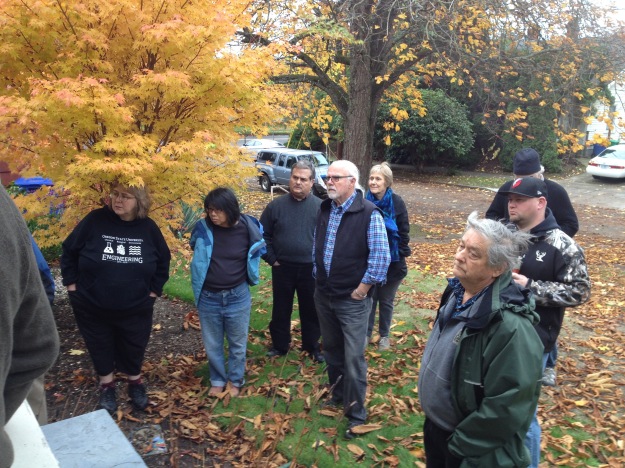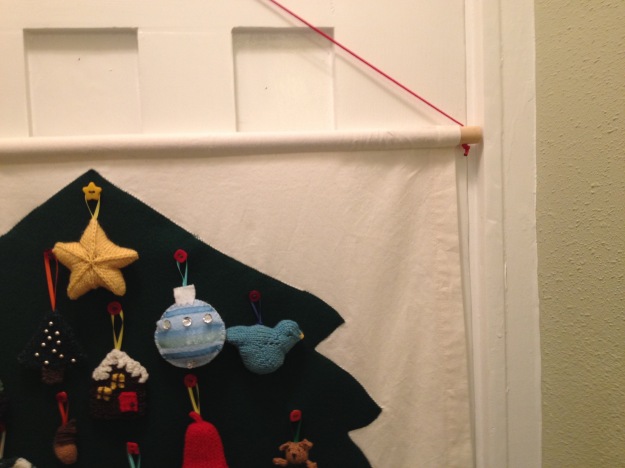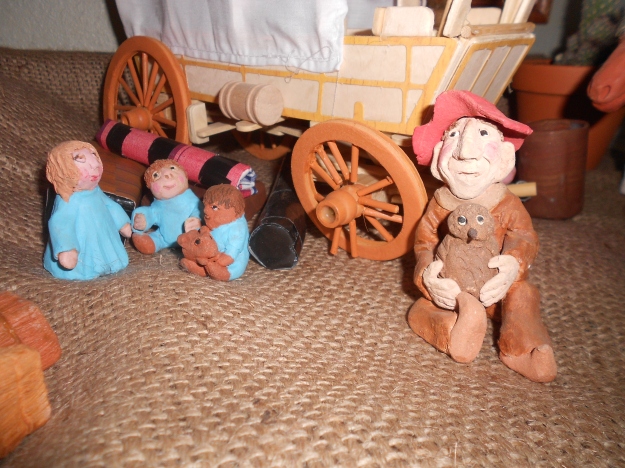“Never doubt that a small group of thoughtful, committed citizens can change the world; indeed, it’s the only thing that ever has.” – Margaret Mead
Last June, the Unitarian Universalist General Assembly (annual meetings) was held in Portland. There is always some kind of public witness event at these meetings, and last summer’s was about global climate change. Part of the ritual involved taking a piece of ribbon and writing a commitment on it, then hanging it on a tree outside the convention center. (Sort of like Tibetan prayer flags.) Except it was such a blisteringly hot day that we ended up holding the event inside the air-conditioned convention center… no trees.
I brought my blank ribbon home, as did my husband, and somehow we had acquired a third one as well. I thumbtacked them to the outside of my front door as a visual reminder that I had made a commitment to do something about climate change, though I didn’t yet know what that would be.
Perhaps a week later, as I was walking my dog home from the park, a neighbor stopped me on the sidewalk and, without preamble, said “I’m so concerned about climate change! Isn’t there something we can do? There must be something we can do at a neighborhood level. Will you do something with me?”
I didn’t know this woman well, only well enough to call her by name (Lynn) and say hello when I walked past her house. As we talked on the sidewalk that morning, her husband Michael joined us, and we decided to get together one evening that week to brainstorm what we might do.
My husband was interested as well, so we two couples started meeting about every two weeks over the summer to talk about how we might encourage our neighbors to get involved in something regarding climate change; we still didn’t know what it would be. At each meeting each of us made a commitment to do something specific, and at each subsequent meeting we reported back on what we had done.
We read some books: Joanna Macy’s Active Hope; Rebecca Solnit’s A Paradise Built in Hell; and This Changes Everything, by Naomi Klein. We started searching the Internet for resources that the City of Portland had organized, and we went to some meetings.
The place to start, we realized, was with neighborhood resiliency — building a network of neighbors who know each other and can offer immediate help if there’s trouble. We also decided early in the process that we would intentionally blur the boundaries between preparing for an earthquake or other natural disaster and responding to climate change, reasoning that climate change can (unfortunately) still be a political issue on which people might disagree, whereas no one can argue with the possibility of an earthquake in the Pacific Northwest. It’s definitely coming.
There is a long history of neighborhood block parties held for the 33 households on our block, so we decided to start there, holding a September 1 gathering. I made flyers which were distributed by hand to every household; on the day of the party, when rain threatened, I took reminder flyers to every house again, saying that the party would happen rain or shine.
Seventeen households were represented at the block party — about half the neighborhood. People wore name tags and were friendly in introducing themselves and finding various common threads. The only “business” was a brief announcement that we wanted to build neighborhood resilience by encouraging connection among us, which would start with a moderated e-mail list. Nearly everyone there signed up for the list. We also announced where the city-designated gathering place in our neighborhood is in the event of an earthquake.
We two couples met the next morning to de-brief and figure out who hadn’t attended, and we divided up that list to go door-to-door explaining that we were creating an e-mail list for neighborhood connection. We now have nearly every household on the list.
We decided to call ourselves “58th Avenue Resilience.” Our next effort was a little tour of the neighborhood on a Saturday morning in November, to show people what has already been done by some of us. One house has been bolted to its foundation, and they also strapped their water heater to the wall.
Lynn and Michael have solar panels on their roof and a sophisticated water reclamation system. Our next-door neighbor demonstrated what should go in an emergency go-bag, with a handout about where to get the supplies. We have an earthquake emergency gas shutoff valve. 
Also last Fall, Lynn attended a national climate activists training workshop sponsored by Al Gore, and she came home on fire! There were only a few attendees from Oregon, but they were significant contacts for us: a high-level volunteer with 350PDX (the Portland chapter of Bill McKibben’s organization, 350.org); and Bill Bradbury, the former Secretary of State for Oregon, who has become a full time climate activist now that he is out of office.
Lynn was so inspired by her few days of work with Bradbury that she wanted him to come give a presentation in Portland. He agreed to a Tuesday evening in January, and Lynn set to work getting co-sponsorship from 350PDX and two other significant environmental organizations, The Oregon Environmental Council and Renew Oregon. We got wide publicity through those three organizations, and we also sent publicity to every newspaper, radio station, business consortium, outdoor group, and any other organization that might be remotely interested. (Portland is loaded with such groups!)
Despite the fact that the State of the Union Message was in direct conflict with our event, and that it had been raining hard all day, we filled the sanctuary of a large neighborhood community center-church with about 200 attendees for Mr. Bradbury’s presentation. Though the event was free and open to the public, Lynn had suggested pre-registration, so we knew to expect a large crowd and we decided just a few days earlier to announce that this would be the first of a monthly series of presentations related in some way to climate change.
I had designed a simple survey for the audience to fill out, asking what other topics they would like to hear about and whether anyone would like to help us in future efforts. The survey responses clearly indicated that we were onto something, and that people were hungry to learn more about the myriad issues related to climate change.
By this time I had invited another friend to join our planning group, a recently retired Professor of Environmental Studies who had moved to Portland the previous summer (around the time we were just getting started). She has proven to be a goldmine of resources and ideas, and she has clearly done her homework about how things work in this city and what the relevant organizations are for climate activists — in six months she has learned more about Portland than I’ve learned in four years.
The February event consists of two people involved with community solar power generation (as compared to individual rooftop installations) who will offer their expertise on solar cooperatives, policy tools, social equity considerations, and the current state of legislation to support these efforts. In March we will have a presentation by the city of Portland Department of Planning and Sustainability, talking about the City/County Climate Action Plan that was adopted last summer, and how they foresee it being implemented. The April event will, we hope, be a candidates forum among the leading candidates for Mayor of Portland, focusing on climate issues (we’re only in the earliest stages of planning that one). And in May we’ll have a panel discussion about climate justice, with representation from some of Portland’s minority communities.
To distinguish ourselves from “58th Avenue Resilience,” which really is just our block, we are calling this monthly series “Let’s Talk Climate.” In sending out publicity for our February event, I’ve been delighted to learn how cooperative and eager many organizations are to help publicize this effort. I haven’t hesitated to explain that “Let’s Talk Climate” is just five people who want to do something; we have no structure, no by laws, no money, and no restrictions. Thus we are nimble, flexible, and creative.
I constantly remind myself of the quote attributed to Margaret Mead: “Never doubt that a small group of thoughtful, committed citizens can change the world; indeed, it’s the only thing that ever has.” We don’t expect to singlehandedly reverse climate change, or even to make a dent in the mountain of huge issues facing humanity as we (hopefully) adapt to the ways our lives will be affected by this crisis. But this tiny effort of ours might at least be helpful to someone in a modest way. I couldn’t ask for much more than that.



 I started with
I started with 
 Yes, with fingering yarn and size 1 needles, you really do need that many stitches. I ended up making a bigger one (worsted weight, size 5 needles) as a Christmas gift for my 100-year old mother-in-law, and an even bigger one (worsted weight AND fingering weight, size 6 needles) for the top of our tree.
Yes, with fingering yarn and size 1 needles, you really do need that many stitches. I ended up making a bigger one (worsted weight, size 5 needles) as a Christmas gift for my 100-year old mother-in-law, and an even bigger one (worsted weight AND fingering weight, size 6 needles) for the top of our tree.  This pattern is definitely a keeper! Once you figure out the pattern, it works like a charm, and it’s all one piece!.
This pattern is definitely a keeper! Once you figure out the pattern, it works like a charm, and it’s all one piece!. Be sure to do any embroidery before you put the pieces together!
Be sure to do any embroidery before you put the pieces together!

 Be sure to leave long yarn ends (for sewing together) for both the cast-on and the bind-off on the cat. Can’t find the original pattern, but here’s
Be sure to leave long yarn ends (for sewing together) for both the cast-on and the bind-off on the cat. Can’t find the original pattern, but here’s  As Stephanie did, I took out two rows of the bottom because these didn’t need to stand up (that is, omit the first two rows of the directions for The Base); for the mast, I did a 3-stitch i-cord rather than 4, and worked 26+ rows rather than 24. I used a bent paper clip rather than a pipe cleaner for the mast, ran it through first and then cut it to size. Very happy with how these turned out!
As Stephanie did, I took out two rows of the bottom because these didn’t need to stand up (that is, omit the first two rows of the directions for The Base); for the mast, I did a 3-stitch i-cord rather than 4, and worked 26+ rows rather than 24. I used a bent paper clip rather than a pipe cleaner for the mast, ran it through first and then cut it to size. Very happy with how these turned out! Perhaps I should have stuffed them fatter. Mods as follows: c/o 22 stitches, work 12 rows for legs, 9 rows for upper body. For head, rows 1-5 are st. st., on row 6, decrease 6 stitches (16 remain); on row 8, decrease 7 stitches (9 remain); on row 10, decrease 4 stitches (5 remain); then purl across the next row, draw yarn through remaining stitches, and pull up.
Perhaps I should have stuffed them fatter. Mods as follows: c/o 22 stitches, work 12 rows for legs, 9 rows for upper body. For head, rows 1-5 are st. st., on row 6, decrease 6 stitches (16 remain); on row 8, decrease 7 stitches (9 remain); on row 10, decrease 4 stitches (5 remain); then purl across the next row, draw yarn through remaining stitches, and pull up.


 20) The pants with no one inside them were a find of my own and I love them so much! But now I can’t find the pattern. Here it is, taken from my printout:
20) The pants with no one inside them were a find of my own and I love them so much! But now I can’t find the pattern. Here it is, taken from my printout: Mostly because I had exactly the right yarn, a sort of mottled, tweedy-ish green sock yarn, as yet unused. The small amount of yarn I used will probably not diminish the size of the eventual socks. Here’s how I did it:
Mostly because I had exactly the right yarn, a sort of mottled, tweedy-ish green sock yarn, as yet unused. The small amount of yarn I used will probably not diminish the size of the eventual socks. Here’s how I did it:
 As you will see, this pattern includes many little things that could be used for an Advent Calendar.
As you will see, this pattern includes many little things that could be used for an Advent Calendar. (My notes to myself are a bit vague here, so you might have to experiment.) Directions: using size 1 needles and fingering weight red yarn, cast on 18 stitches, using a twisted cast-on and leaving a very long end for an eventual three-needle bind-off. Row 1: K 14, purl 4; row 2: knit. Repeat these 2 rows until you have 23 ridges (46 rows). Leave working yarn attached so you can make an i-cord top for the bell. Using the very long end of the cast on, do a 3-needle bindoff with right sides together (cast on and working edges); bottom edge of bell should turn under. Gather the top, then make an i-cord about 3/4″ long. Tie some little jingle bells inside.
(My notes to myself are a bit vague here, so you might have to experiment.) Directions: using size 1 needles and fingering weight red yarn, cast on 18 stitches, using a twisted cast-on and leaving a very long end for an eventual three-needle bind-off. Row 1: K 14, purl 4; row 2: knit. Repeat these 2 rows until you have 23 ridges (46 rows). Leave working yarn attached so you can make an i-cord top for the bell. Using the very long end of the cast on, do a 3-needle bindoff with right sides together (cast on and working edges); bottom edge of bell should turn under. Gather the top, then make an i-cord about 3/4″ long. Tie some little jingle bells inside. drew the ensuing triangle onto the paper, then shaped the edges to make it into a tree shape, folding it in half before cutting so it would be symmetrical.
drew the ensuing triangle onto the paper, then shaped the edges to make it into a tree shape, folding it in half before cutting so it would be symmetrical.  I used this pattern on green felt to make the tree (and I.T.W.A.N.T., I would put a small trunk under the tree), and used the remaining green felt for the pockets. This was all pretty seat-of-the-pants and unscientific.
I used this pattern on green felt to make the tree (and I.T.W.A.N.T., I would put a small trunk under the tree), and used the remaining green felt for the pockets. This was all pretty seat-of-the-pants and unscientific. to attach the tree with four rows of six pockets under it, all the same size and big enough to accommodate the largest item.
to attach the tree with four rows of six pockets under it, all the same size and big enough to accommodate the largest item.
 I discovered I had buttons to spell out the name of one child. Do you see it?
I discovered I had buttons to spell out the name of one child. Do you see it?























































